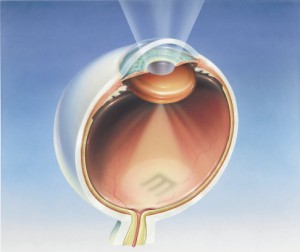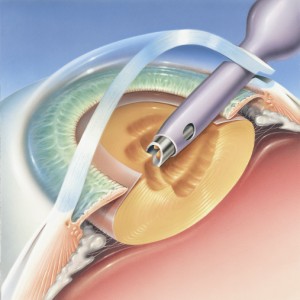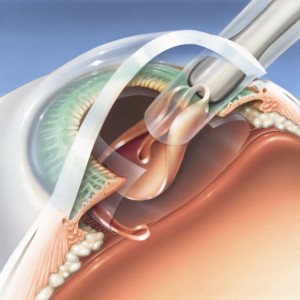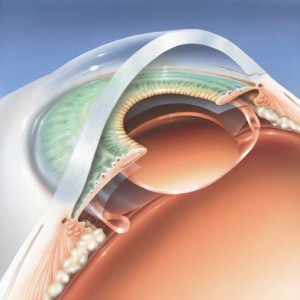Vision Centre
Southport and Robina
Gold Coast Queensland Australia
Cataracts
Cloudy Lens Syndrome
Worried about a Cataract?
![]() Please don't be! Cataract treatment by surgery is a very common procedure, especially for people over 65 years of age. Cataract operations are safe and fast, and you should enjoy much better vision once your procedure and after-care is completed.
Please don't be! Cataract treatment by surgery is a very common procedure, especially for people over 65 years of age. Cataract operations are safe and fast, and you should enjoy much better vision once your procedure and after-care is completed.
What exactly is a Cataract?
![]() Cataracts usually take a long time to develop - months and even years. Cataracts are changes in the clarity of the natural lens within the eyes which prevent light from reaching the retina and interfere with vision. Sooner or later cataracts affect almost everyone.The lens of the eye is made of mostly water and proteins. As ageing occurs the proteins clump together and cause cloudiness. Other contributing factors may include; family history, eye surgery, puncture wounds, medications such as corticosteroids, chronic inflammation and diabetes, though ageing is the main factor. In
addition, smokers as opposed to non-smokers have a higher rate of cataract occurrence.
Cataracts usually take a long time to develop - months and even years. Cataracts are changes in the clarity of the natural lens within the eyes which prevent light from reaching the retina and interfere with vision. Sooner or later cataracts affect almost everyone.The lens of the eye is made of mostly water and proteins. As ageing occurs the proteins clump together and cause cloudiness. Other contributing factors may include; family history, eye surgery, puncture wounds, medications such as corticosteroids, chronic inflammation and diabetes, though ageing is the main factor. In
addition, smokers as opposed to non-smokers have a higher rate of cataract occurrence.

Cataract-affected eye
![]() In a normal eye the clear cornea allows light to enter a clear lens, then through the vitreous
(the clear jelly that fills the eye). The light is focused on the back of the eye, the retina, creating a sharp
image that is transmitted to the brain via the optic nerve. When the eye has cataract, the light must pass through
a cloudy lens. The lens scatters the light making it difficult to focus through the cataract, this causes blurring
of the image. A cataract on the edge of the lens may not affect central vision but a cataract in the middle of a
lens is likely to interfere with vision and perception of color.
In a normal eye the clear cornea allows light to enter a clear lens, then through the vitreous
(the clear jelly that fills the eye). The light is focused on the back of the eye, the retina, creating a sharp
image that is transmitted to the brain via the optic nerve. When the eye has cataract, the light must pass through
a cloudy lens. The lens scatters the light making it difficult to focus through the cataract, this causes blurring
of the image. A cataract on the edge of the lens may not affect central vision but a cataract in the middle of a
lens is likely to interfere with vision and perception of color.
What are the Effects of Cataracts?
- Dim, blurry or clouded vision
- Reduced night vision
- Increased sensitivity to bright sunlight or car headlights
- Halo effect around lights
- A need for brighter light when reading or doing other things
- Increased frequency of changes in your contact lens or spectacle prescriptions
- Double vision or perhaps ghost images in one eye
- Fading or yellowing of colour perception
How are Cataracts Treated?
![]() The treatment for cataracts can vary depending on how advanced the individual cataract. Vision can be corrected with glasses or contact lenses prior to the need for cataract lens implant surgery in early stages. However the only treatment for a visually significant cataract is surgical removal. Advanced cataracts cloud the natural lens and refractive correction may not improve vision.
The treatment for cataracts can vary depending on how advanced the individual cataract. Vision can be corrected with glasses or contact lenses prior to the need for cataract lens implant surgery in early stages. However the only treatment for a visually significant cataract is surgical removal. Advanced cataracts cloud the natural lens and refractive correction may not improve vision.
![]() A cataract operation involves the removal of the cloudy lens and replacement with an artificial Intra-Ocular Lens (IOL) implant. Phacoemulsification involves a tiny incision in the eye through which the cataract is broken up by ultrasound and vacuumed out. A folded IOL is inserted through the same incision which unfolds within the eye.
A cataract operation involves the removal of the cloudy lens and replacement with an artificial Intra-Ocular Lens (IOL) implant. Phacoemulsification involves a tiny incision in the eye through which the cataract is broken up by ultrasound and vacuumed out. A folded IOL is inserted through the same incision which unfolds within the eye.

A cataract-affected eye prior to surgery.

The cataract is carefully removed.

A replacement lens is implanted.

Better than ever after surgery.
![]() In the vast majority of cases, patients have better vision after their cataract surgery.
In the vast majority of cases, patients have better vision after their cataract surgery.
About Cataract Surgery
![]() Cataract procedures at Vision Centre are day surgery procedures and usually conducted under a local anaesthetic when you will be fully awake, though comfortable and without pain. Do note that in some cases a light general anaesthetic may be recommended instead. The surgery itself will only take about 20 to 30 minutes and the whole procedure - from entering the day surgery to returning home - usually only takes a few hours. You will not be able to drive after the surgery and should make suitable arrangements for your return home.
Cataract procedures at Vision Centre are day surgery procedures and usually conducted under a local anaesthetic when you will be fully awake, though comfortable and without pain. Do note that in some cases a light general anaesthetic may be recommended instead. The surgery itself will only take about 20 to 30 minutes and the whole procedure - from entering the day surgery to returning home - usually only takes a few hours. You will not be able to drive after the surgery and should make suitable arrangements for your return home.

Your copy of this RANZCO
publication will fully explain
Cataract Surgery
What happens after Cataract Surgery?
![]() Prior to discharge from the day surgery, instructions for post-operative care will be discussed with you. You will be asked to see your doctor the next day, and perhaps several times over the coming weeks. Usually, eyes heal quickly after surgery and vision improves within a few days and sometimes sooner.
Prior to discharge from the day surgery, instructions for post-operative care will be discussed with you. You will be asked to see your doctor the next day, and perhaps several times over the coming weeks. Usually, eyes heal quickly after surgery and vision improves within a few days and sometimes sooner.
![]() Top of Page
Top of Page![]()
Copyright © 2000+ All Rights Reserved